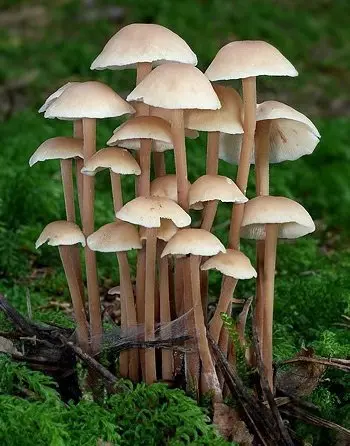Merging money (Gymnopus confluens)
- Division: Basidiomycota (Basidiomycetes)
- Subdivision: Agaricomycotina (Agaricomycetes)
- Class: Agaricomycetes (Agaricomycetes)
- Subclass: Agaricomycetidae (Agaricomycetes)
- Order: Agaricales (Agaric or Lamellar)
- Family: Omphalotaceae (Omphalotaceae)
- Genus: Gymnopus (Gimnopus)
- Type: Gymnopus confluens (Money confluent)
 It occurs abundantly and often in deciduous forests. Its fruit bodies are small, grow in groups, the legs grow together in bunches.
It occurs abundantly and often in deciduous forests. Its fruit bodies are small, grow in groups, the legs grow together in bunches.
Cap: 2-4 (6) cm in diameter, at first hemispherical, convex, then broadly conical, later convex-prostrate, with a blunt tubercle, sometimes pitted, smooth, with a thin curved wavy edge, ocher-brown, reddish-brown, with a light edge , fading to fawn, cream.
Records: very frequent, narrow, with a finely serrated edge, adherent, then free or notched, whitish, yellowish.
Spore powder is white.
Leg: 4-8 (10) cm long and 0,2-0,5 cm in diameter, cylindrical, often flattened, longitudinally folded, dense, hollow inside, first whitish, yellowish-brown, darker towards the base, then red- brown, reddish-brown, later sometimes black-brown, dull, with a “white coating” of small whitish villi along the entire length, white-pubescent at the base.
Pulp: thin, watery, dense, stiff in the stem, pale yellow, without much odor.
Edibility
The use is not known; foreign mycologists often consider it inedible due to the dense, indigestible pulp.









